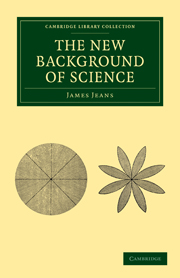Book contents
- Frontmatter
- Contents
- Preface to the First Edition
- Preface to the Second Edition
- Chapter I The Approach to the External World
- Chapter II The Methods of Science
- Chapter III The Framework of the External World—Space and Time
- Chapter IV Mechanism
- Chapter V The Texture of the External World—Matter and Radiation
- Chapter VI Wave-Mechanics
- Chapter VII Indeterminacy
- Chapter VIII Events
- Index
Chapter I - The Approach to the External World
Published online by Cambridge University Press: 07 September 2010
- Frontmatter
- Contents
- Preface to the First Edition
- Preface to the Second Edition
- Chapter I The Approach to the External World
- Chapter II The Methods of Science
- Chapter III The Framework of the External World—Space and Time
- Chapter IV Mechanism
- Chapter V The Texture of the External World—Matter and Radiation
- Chapter VI Wave-Mechanics
- Chapter VII Indeterminacy
- Chapter VIII Events
- Index
Summary
Twentieth-Century Physics
A century which has run less than a third of its course has already witnessed two great upheavals in physical science. These are associated with the words Relativity and Quanta, and have forced the physicist of to-day to view nature against a background of ideas which is very different from that of his nineteenth-century predecessor.
The latter thought of nature as an assemblage of objects located in space and continually changing with the passage of time. It was something entirely detached from, and external to, himself; something which he could study and explore from a distance as the astronomer studies the surface of the sun through his telescope, or the explorer the desert from his aeroplane. He thought of the apparatus of his laboratory as the astronomer thinks of his telescope, or the explorer of his field-glass; it shewed him things which were there whether he looked at them or not, which had been there before the first man appeared on earth, and would still be there after the last man had been frozen to extinction. Finally he accepted a “common-sense” view of nature, believing that there was no great difference between appearance and reality; the possibility that things were not as they seemed might provide an admirable subject for a debating society of philosophers, but was of as little practical concern to the scientist as to the farm-labourer.
Although he may not have realised it, this complex of beliefs constituted a philosophical creed in itself.
- Type
- Chapter
- Information
- The New Background of Science , pp. 1 - 47Publisher: Cambridge University PressPrint publication year: 2009First published in: 1931



